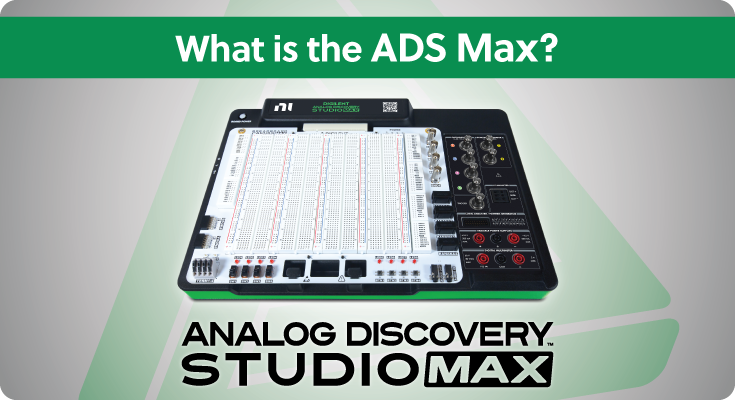Consider Dash if you’ve ever wanted to create a web browser application using Python. With Dash, you don’t need to be good at using JavaScript, great at Cascading Style Sheets …
Featured
Recent Articles
Introducing the ADS Max, a powerful new tool designed to enhance your lab and learning experience. Our in-depth FAQ addresses your most common questions, from technical specifications and software compatibility …
The Analog Discovery Studio Max (ADS Max) is a comprehensive tool for electronics education, integrating all the essential instruments you need into a single, portable device. While it boasts a …
At Digilent, we believe in empowering the next generation of engineers, educators, and innovators. That’s why we offer a fantastic 15% academic discount on all products in our store for …
Hi there Digilent Blog readers! I’m Dr. Brian Faulkner, professor of Electrical Engineering at Milwaukee School of Engineering in Milwaukee, Wisconsin, USA, where I teach introductory circuit theory and power …
We’re thrilled to announce that Digilent’s Analog Discovery Pro (ADP2230) has been recognized as the “Best Test and Measurement of the Year (Most Promising Product)” at the EE Awards Asia! …
Popular Posts
At Digilent, we understand the evolving needs of engineering education. That’s why we’re thrilled to introduce the Analog Discovery Studio Max (ADS Max), a versatile and comprehensive electronics laboratory solution …
A small post for Digilent’s largest products. All three rebranded NI VirtualBenches are now sold by Digilent and supported by WaveForms on Windows Fastest and highest bandwidth mixed signal …
Let’s talk about clocking. It’s crucial to the functionality of FPGA boards and digital design in general, as all synchronous logic depends on clocks. In this article, we’ll define some …
Shifting Academic Focus In late June, Digilent attended the American Society of Engineering Education (ASEE) Annual Conference. We’re no strangers to the event, and have been proud to show off …
Brandon K. provides a quick rundown on the nuances of notation.
If you’ve been around electronics for a while, you’ve probably noticed that components like resistors, capacitors, zener diodes and inductors come in some odd values. Looking at the chart above, there seems to be no clear rationale behind the values, but there is a pattern. 47kΩ resistors and 22μF capacitors are everywhere, but not 40kΩ or 50kΩ resistors, or 20μF or 30μF capacitors. So what’s the deal? It all has to do with preferred numbers.
Today we will go over a brief overview on FPGAs!
At this point in reading the blog and going through the learn material, you might realize that there is a lot of FPGA code. It doesn’t look like C, it doesn’t look like Java…what is it?



